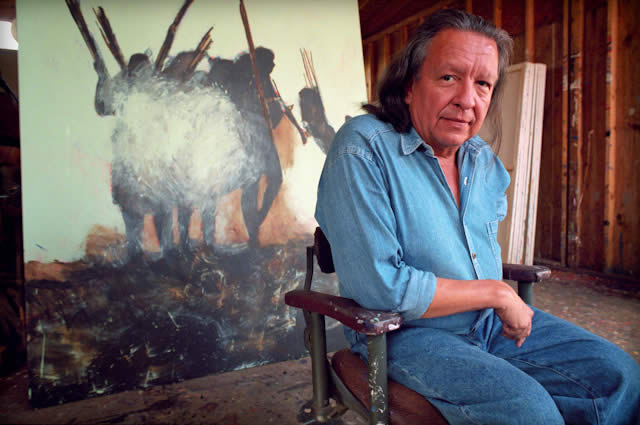Andy was in the phone book
May 16th, 2012 by dave dorsey
My good friend Donna Rose at artbrokerage.com sent me a link to a wonderful interview with her favorite art teacher, Fritz Scholder, who died a few years ago. It ranges all over the place, and it’s all refreshing. Some samples:
- All kids draw. I never stopped. I was real shy, and all I wanted to do was stay in my room and draw, so I wouldn’t have to deal with people. This, at the time, was difficult. But in retrospect, I always knew what I had to be. There was never any question. It was all that I could do. Plus, I was a rebel, right from the beginning. If someone told me to do something, I’d do the opposite. So I was, in a way, a bad boy in school . . . . You have to realize that at times art was really pretty foreign. For most people, an artist meant going to Paris and starving in a garret. No one was making a living in this country, except for Georgia O’Keeffe and Thomas Hart Benton. And so, what one did was to get degrees and teach at a university, and if you were good, you might be able to get an artist-in-residency. So, it was pretty bleak to think that you could be an artist.
- Picasso would paint way into the night. He’d wake up at two in the afternoon, and he always woke up grumpy. Françoise Gilot had to be there when he woke up and hear the same litany every day. “Oh, I feel terrible! It’s a terrible day. I have no friends. Matisse hasn’t written to me.” And he would go down the line. She’d sit there quietly until he was through, then she would say, “Pablo, you look great and I just saw the paintings you did last night and they’re great, and there’s a letter from Matisse right on the table over there, and the day is beautiful.” Finally, a little smile would come on his face. “Well, I think I’d better get up and do something.”
- Most people are very accessible. Andy Warhol was listed in the phone book when he was alive. You could call Andy and, if he felt like it, he might invite you over. When I was a young painter in New Mexico I’d heard the horror stories about Georgia O’Keeffe, how she never answers her mail, she never sees anyone, she turns away Life magazine. But I tell the students, “You must make your gesture, by coming halfway and presenting yourself.” No more, that would be intruding, no less, because then you’d be bad to yourself. So I wrote a fan letter to Georgia and said I was a young painter, I’d just come to New Mexico, I’d like to visit her. I put it in the mailbox and thought, “Well, I’ve done my duty.” By return mail I received a hand-scrawled terse letter saying, “Dear Mr. Scholder, I don’t know why you’d want to see me. You can come Thursday afternoon.”
- My teacher, Wayne Thiebaud, was mislabeled a pop artist when he started painting pies and cakes. Wayne was not interested in the pop movement. He was a historian who had seen the edibles on the tabletop of Monet and took it from that. So often, popular media will pounce on something and not be accurate, but you’re stuck with it. Usually forever, because they hardly ever come back and do an update.
- A fine artist must do exactly what he wants to do, with no pressure. Whether it’s from your parents, your girlfriend, your wife, you must block all that out. Fine art, if it’s the highest form of human expression, means self-integrity. And when you’re in that studio, you must do whatever you do completely for yourself. And you must be your own worst critic. Which means that after you’ve done it, you must live with it, decide if it should leave the studio. Often I destroy the work, either at the moment, or right after I’ve done it, or days later, or years later. I still will go in the studio at night and destroy paintings, because they’re mine.
- Especially today, the artist is more important than ever, because the individual is fighting for his life in this cybernetic age. I recently gave a commencement address, in which I said the shaman-artist has now drawn the line and has begun the fight against the cyber-technocrat. It’s not that I’m against computers, but I think that the human being has to be very careful in the coming millennium. That’s the subject of my new series of paintings, because it’s pretty scary what may happen.
- You have to be your own worst critic. Painting is very much a maturing process. This is nice, because at the end of your life you can be doing your best work. Hokusai, the great painter, on his death bed at 102, said, “If I could only have one more day, I could do a great painting.”
- Georgia O’Keefe truly floated, instead of walked. She talked in poetry. As we crossed the famous patio, with the black door that she’d painted so often, she said something to me I’ll never forget. She said, “There are times when one must spend an afternoon with one who one will never see again.”

Comments are currently closed.